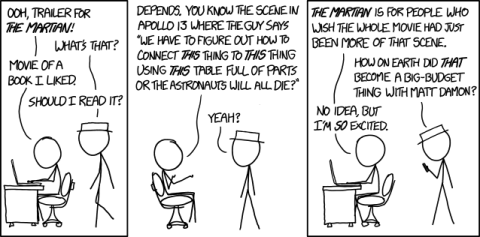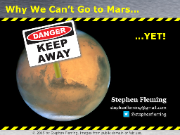Why am I using my monthly newsletter column to talk about a Matt Damon movie? Because it’s relevant to Georgia Tech.
Last week, I was fortunate to score a handful of passes to an advance screening of “The Martian.” Unless you’ve been living under a rock, you know this is Ridley Scott’s new big-budget movie starring Matt Damon as a NASA astronaut stranded on Mars. It opens Friday, and you should go see it.
Somewhat surprisingly for Hollywood, “The Martian” movie is faithful to “The Martian” book by Andy Weir — which is one of my favorite books of the last few years. Which means I have no idea how this movie actually got green-lighted for production.
The protagonist, Mark Watney, is a mechanical engineer, a botanist, and a bit of a smartass. When he wakes up alone on Mars, he has to solve a series of problems to survive until he can be rescued (if you haven’t read the book, I’m not going to put spoilers here). Placed in a series of nearly-impossible situations, he never gives up, never gives in, and always proceeds step by step to break the problem down into manageable chunks.
Devin Faraci posted a review that I wish I had written:
It’s a movie dedicated to the greatest side of humanity that is so rarely celebrated in film, our can-do problem solving nature… It’s a movie that reminds us that all of the problems facing our world are surmountable, and that with the right attitude and the right math and the right dedication, we can solve them all, one after another. “The Martian” isn’t about some namby-pamby feeling of hope, it’s a step-by-step guide to achieving the change for which we hope.
Bingo.
Yes, the book exaggerates some scientific risks and simplifies others for the sake of a good story (and the movie, as you might expect, pushes that knob even closer to eleven). No, the mission couldn’t actually proceed exactly as shown on screen (although the orbital mechanics are spot on, and it at least makes nods in all the right technical directions). No, NASA’s buildings aren’t nearly as cool as those in the movie. But, heck… the guy saves his own life using duct tape! To heck with the quibbling… he’s a helluva engineer!
I can’t help comparing “The Martian” to an earlier science fiction movie this year (which also stranded Matt Damon on an alien planet… what a bizarre niche to get typecast into!): “Interstellar.” Hugely ambitions, visually gorgeous, with a strong cast of actors… and the scientific message at the end of all of their interstellar wanderings is a bit of philosophical hooey from Anne Hathaway’s character about the power of love:
“Love is the one thing we’re capable of perceiving that transcends dimensions of time and space.”
Meh.
Mark Watney would snort derisively at Anne, make a rude (and probably obscene) comment, crank up the Donna Summer MP3s, and return to drilling holes in the roof of his Mars rover.
I know who I’d rather trust to get me off an alien planet that’s trying to kill me.
First connection to Georgia Tech: this is exactly the sort of person that I hope Georgia Tech is graduating. Smart, resilient, creative, and determined to find solutions to hard problems. If Watney were a real person, I’d be mailing him a Georgia Tech hoodie to wear! As it is, I hope every Georgia Tech student is reading the book (which goes into a lot more engineering humor than the movie could manage).
Like Tom Wolfe before him (in “The Right Stuff,” another paean to NASA that became an excellent movie), Andy Weir absolutely nails the mindset of an engineer faced with a set of problems. “I’ve tried A, I’ve tried B, I’ve tried C!” And he keeps on trying. Until it works. (Okay, that was a spoiler. It’s Hollywood. You knew it would work.)
Second connection to Georgia Tech: NASA cooperated in the development of the film, and it shows. The spacecraft, the suits, the equipment — all of them are extrapolated from NASA’s designs for real Mars missions starting around 2030. (As some of you know, I kicked up a little dust at DragonCon this year by explaining “Why We Can’t Go to Mars.” Weir acknowledges that we’re not going to go to Mars before 2030, and that there’s a lot of hard engineering work to be done before we’re ready. And he simply ignores the very real problem of radiation exposure, since that will probably mean an underground Martian habitat that wouldn’t look good on screen.)
Now, in a nice bit of jujitsu, NASA is using a fictional movie to generate interest in real planetary science. After preliminary results have circulated for several years, a NASA press conference this week confirmed the presence of liquid water flowing seasonally on Mars. This is a big deal… not because the result is that surprising (it’s been hypothesized for years) but that it’s been firmly established from orbital measurements through a peer-reviewed process.
As Emily Lakdawalla wrote this week:
It’s really a lovely example of the scientific process working, and it doesn’t happen very often in planetary science. Our instruments are so coarse, our understanding so generally poor, that it’s a rare thing to enjoy this cycle of observation, hypothesis, test, confirmation. Look at what’s happening on Pluto this year: the photos are absolutely amazing but, for the most part, scientists have no idea how to explain what we see.
And who did that hard, sometimes tedious, sometimes insightful science? The two lead authors on the paper are Lujendra Ojha and Mary Beth Wilhelm, two Ph.D. students in Georgia Tech’s School of Earth and Atmospheric Sciences.
Yep, we’re Georgia Tech. We can do that!
The third connection to Georgia Tech is the most personal but the least important: author Andy Weir will be participating in a live videoconference this Sunday at the Atlanta Maker Faire in Decatur. They’ve invited me to conduct the interview with him, and I’m really looking forward to it. Tickets are free, but will probably sell out, so get yours now!
And whether you come to Decatur or not… the movie opens Friday. Go see it!




The orbital mechanics aren’t spot on. The Hermes ion engine can accelerate the craft at 2 mm/s^2. Hermes departs for Mars from Low Earth Orbit (LEO). From LEO it would take more than a month to spiral out of earth’s gravity well. The extra month spent in earth’s neighborhood renders the 124 day trip implausible.
If the Hermes had departed from EML2, the trajectory would be believable.